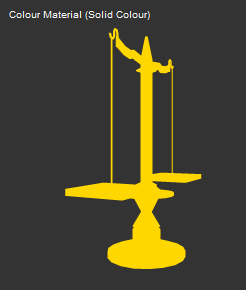Posts Tagged ‘Papervision’
As soon as you thought you had it all going down and dusted with Papervision3D 2.0 (Great White), guess what!?
A new release is in the making.. this will be known as
PAPERVISION X
Papervision X is the next version of Papervision3D and it is written completey from scratch, no recycled code, no rubbish. It is designed base on Flash10’s new 3D API. This will allow Papervision to take full advantage of the new 3D engine and 3D features in Flash Player 10.
You will also be happy to know that “Beta” titles will be out the window, and dot versioning will be used, which will make life a lot easier for everyone.
Dont worry just yet, PV2.0 isnt dead – there are still loads of features that are going to be made to the engine, and it looks like it will take quite some time until FP10 adoption rate is high enough before the plug is pulled.
This Part of the Shaders Tutorial series will show you how to add Flat shader material to either a dae imported object or to a basic primitive.
If you are a novice, it is advised that you follow this tutorial from the initial section that can be found here, which explains how to set up the files and the scene. Otherwise please read on.
For those following on the shaders tutorial series, i will be calling this .as file flatMat
to begin with we must begin the package and import the relevant classes
package flatMat {
import flash.display.Sprite;
import flash.events.Event;
import flash.text.TextField;
import flash.text.TextFormat;
import org.papervision3d.cameras.CameraType;
import org.papervision3d.lights.PointLight3D;
import org.papervision3d.materials.shadematerials.FlatShadeMaterial;
import org.papervision3d.materials.shadematerials.CellMaterial;
import org.papervision3d.materials.utils.MaterialsList;
import org.papervision3d.objects.primitives.Sphere;
import org.papervision3d.render.BasicRenderEngine;
import org.papervision3d.view.BasicView;
import org.papervision3d.objects.parsers.DAE;
import org.papervision3d.objects.DisplayObject3D;
now we must begin the class, and add the variables that we will be using
This Part of the Shaders Tutorial series will show you how to add Cell shader to either a dae imported object or to a basic primitive.
If you are a novice, it is advised that you follow this tutorial from the initial section that can be found here, which explains how to set up the files and the scene. Otherwise please read on.
For those following on the shaders tutorial series, i will be calling this .as file cellMat
package cellMat{
we then need to import our classes
import flash.display.Sprite;
import flash.events.Event;
import flash.text.TextField;
import flash.text.TextFormat;
import org.papervision3d.cameras.CameraType;
import org.papervision3d.lights.PointLight3D;
import org.papervision3d.materials.shadematerials.CellMaterial;
import org.papervision3d.materials.utils.MaterialsList;
import org.papervision3d.objects.primitives.Sphere;
import org.papervision3d.render.BasicRenderEngine;
import org.papervision3d.view.BasicView;
import org.papervision3d.objects.parsers.DAE;
import org.papervision3d.objects.DisplayObject3D;
now we must initiate our class, and set our variables
public class cellMat extends Sprite
{
private var view:BasicView;
private var cell:CellMaterial;
private var light:PointLight3D;
private var sphere:Sphere;
private var angle:Number = new Number(0);
private var tf:TextField;
private var format:TextFormat;
private var dae:DAE;
private var daeFile:String;
private var daeMaterialName:String;
This Part of the Shaders Tutorial series will show you how to add colorMaterial shader to either a dae imported object or to a basic primitive.

Colour Material Shader Example
If you are a novice, it is advised that you follow this tutorial from the initial section that can be found here, which explains how to set up the files and the scene. Otherwise please read on.
This code is pretty basic / self explanatory, so I will not be explaining much about it. If you do require any help, just post a comment below.
package colorMat {
import flash.display.Sprite;
import flash.events.Event;
import flash.text.TextField;
import flash.text.TextFormat;
import org.papervision3d.cameras.CameraType;
import org.papervision3d.materials.ColorMaterial;
import org.papervision3d.materials.utils.MaterialsList;
import org.papervision3d.objects.primitives.Sphere;
import org.papervision3d.render.BasicRenderEngine;
import org.papervision3d.view.BasicView;
import org.papervision3d.objects.parsers.DAE;
import org.papervision3d.objects.DisplayObject3D;
public class colorMat extends Sprite
{
private var view:BasicView;
private var color:ColorMaterial;
private var sphere:Sphere;
private var tf:TextField;
private var format:TextFormat;
private var dae:DAE;
private var daeFile:String;
private var daeMaterialName:String;
This Part of the Shaders Tutorial series will show you how to add an Environmental Material Shader to your objects.
What this basically does is take a texture imported from the background and use it to reflect off the object, giving the object a highly reflective coating which is faked. This keeps processing power down, while giving a nice effect.
For this tutorial we will be creating an effect that looks something like this: (please be patient while the video loads)
If you are a novice, it is advised that you follow this tutorial from the initial section that can be found here, which explains how to set up the files and the scene. Otherwise please read on.
To begin with, we must begin our new package and import our classes.
package environmentMat{
import flash.display.BitmapData;
import flash.display.Loader;
import flash.display.Sprite;
import flash.events.Event;
import flash.net.URLRequest;
import flash.text.TextField;
import flash.text.TextFormat;
import org.papervision3d.cameras.CameraType;
import org.papervision3d.lights.PointLight3D;
import org.papervision3d.materials.shadematerials.EnvMapMaterial;
import org.papervision3d.objects.primitives.Sphere;
import org.papervision3d.render.BasicRenderEngine;
import org.papervision3d.view.BasicView;
//
import org.papervision3d.objects.parsers.DAE;
import org.papervision3d.objects.DisplayObject3D;
//Ability to add materials
import org.papervision3d.materials.BitmapMaterial;
import org.papervision3d.materials.BitmapFileMaterial;
import org.papervision3d.materials.utils.MaterialsList;
Then initialise our class and create the variables that will be using
public class environmentMat extends Sprite {
private var view:BasicView;
private var img:Loader;
private var environment:EnvMapMaterial;
private var light:PointLight3D;
private var sphere:Sphere;
private var angle:Number = new Number(0);
private var tf:TextField;
private var format:TextFormat;
private var dae:DAE;
private var daeFile:String;
private var daeMaterialName:String;



